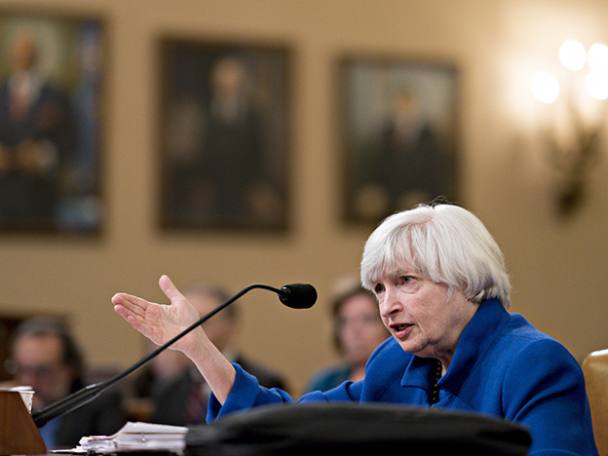This year finally saw the beginning of the end of the great experiment in monetary policy first embarked on by central banks in the wake of the financial crisis a decade ago. But the withdrawal of central bank stimulus risks bond prices falling as yields rise, with the potential for capital loss. So investors need to be on their guard about their fixed-income exposure going into 2018.
The US Federal Reserve has already raised interest rates twice this year and looks set to do so again as we go to press, with more interest rate rises likely next year. And in October, the Fed started unwinding its $4.5 trillion quantitative easing (QE) programme, reducing the amount of bonds it buys by $10bn each month. This will rise to $50bn a month, or $600bn a year, by October 2018.
Closer to home, the Bank of England raised interest rates for the first time in a decade last month. And on the continent the European Central Bank (ECB) recently decided to extend its QE programme until at least September 2018. However, it will also start cutting the amount of bonds it buys each month from €60bn (£53.42bn) to €30bn from January.
Witold Bahrke, senior macro strategist at Nordea Asset Management, says: “What concerns us most is the ongoing regime shift in monetary policy. We are not only seeing conventional tightening – higher interest rates – but now also unconventional tightening – or quantitative tightening – as the Fed reduces its balance sheet. Why could this spook markets? Basically, because it has never happened before. Although there are good reasons why the Fed is doing what it is doing in limiting financial imbalances, central banks are to some degree flying blind in the unwinding of the biggest experiment in recent monetary history.”
But despite the potential risks surrounding fixed income, the latest statistics from the Investment Association show private investors have been piling in to the asset class. Fixed income was the best-selling fund asset class in September, with net retail sales of £1.8bn – its largest ever monthly inflow. It was also the most popular asset class in the third quarter of this year, with net retail sales of £4.9bn.
In stark contrast, many investment analysts have been drastically cutting exposure to fixed income because they are worried about the shifting environment. Darius McDermott, managing director of Chelsea Financial Services, says his firm has reduced allocation to bonds in its cautious portfolios from 40 per cent two years ago to 5 per cent today. Colin Low, managing director of Kingsfleet Wealth, has reduced the fixed-income allocation for clients with balanced portfolios to 10 per cent, down from 20 per cent last year and 30 per cent two years ago. And Jason Hollands, managing director at Tilney Group, is also underweight the asset class.
“Many investors have grown up thinking that bonds are less risky than equities; that is a fatal mistake to make now,” he says. “In this environment of an evolving tone from powerful central bankers and inflation back on the radar, there is potential for further volatility in the bond markets and, frankly, the risk/reward trade-off in many parts of the bond markets is simply highly unappealing.”
Areas to avoid
The yields on developed market sovereign bonds, which have seen prices rise dramatically as a result of central bank action, are looking particularly unappealing. Japanese 10-year government bonds are yielding 0.04 per cent, 10-year German bunds are yielding 0.38 per cent, UK 10-year gilts are paying 1.36 per cent and US 10-year Treasuries are paying 2.39 per cent. And in the UK consumer prices index (CPI) inflation is running at over 3 per cent, meaning the yield investors are getting is negative in real terms.
Gavin Haynes, managing director at Whitechurch Securities, is avoiding gilts for this reason. “Just because textbooks and benchmarks include allocating to gilts in a portfolio [doesn’t mean we have to],” he says. “We are focused on the absolute risks of holding this area and going into 2018 we believe the risk/reward trade-off for investing here remains unattractive on valuation grounds. But we don’t see bond prices collapsing. With economic growth fragile, high political uncertainty and inflationary pressure likely to subside, we see little scope for material increases in the UK and it may be a case of one and done from the Bank of England.”
Nevertheless the UK’s current level of inflation might tempt investors to consider index-linked bonds as the income and maturity values of these assets are adjusted in line with inflation. But the value of these bonds has already risen significantly and they now look very expensive.
“A traditional off-the-shelf index aware fund will have a duration of circa 23 years. Hence if market interest rates rise by 1 per cent there is a 23 per cent capital hit,” explains Rory McPherson, head of investment strategy at Psigma. “When one considers that market interest rates are close to record lows, and more likely to go up than down over the next five years if we get some decent growth, then they look super risky. Add to this that UK break-even inflation rates are expensive – pricing in around 3.4 per cent retail prices index (RPI) over the next five years meaning RPI would need to be more than this for you to make money.”
Selective opportunities
But despite the difficulties in some parts of the fixed-income market, there are still areas that offer opportunities for yield-hungry investors. For example, while inflation-linked bonds in the UK are expensive, US Treasury inflation-protected securities (TIPS) look good value.
Richard Turnill, BlackRock’s global chief investment strategist, says: “US inflation expectations were dented this year due to the surprise slowdown, tied to major one-off drops and moderation in some categories such as housing, but we see inflation expectations firming up as prices climb at a gradual pace.”
He continues: “The US economy is experiencing solid growth. Further job gains could drive the unemployment rate below 4 per cent – low levels rarely seen in the past 50 years. That should spur bigger wage growth.”
But crucially the market is not pricing in this potential for greater than expected inflation, and as a result buying TIPS now could be a good long-term bet.
Floating rate bonds offer a different way of side-stepping interest rate risk. Unlike an ordinary bond, which pays a fixed rate of interest, a floating rate bond has a variable rate that resets based on interest rate changes.
“Floating rate bonds are a slightly more niche investment; they also often have some form of asset backing attached to them,” says Rob Burdett, co-head of multi-manager at F&C Investments. “These could be things like mortgage-backed securities, which were at the epicentre of the credit crunch and a lot of people have been avoiding them for that reason.”
But because mortgage-backed securities have been so unloved by the market they are attractively valued and this allows good fund managers to cherry-pick higher-quality investments. The yields on offer are also higher than other areas of fixed income. However the funds operating in this area tend to be less well diversified than more traditional bond funds.
Short-duration bonds, which are less sensitive to changes in inflation or interest rates, are another option in this environment. James Yardley, senior research analyst at Chelsea Financial Services, says: “Short duration bonds are naturally more liquid than their long-dated cousins. In a rising yield environment this is a particular advantage, as it means the cash flows from frequently maturing bonds can be regularly reinvested at higher yields in the market.”
But Adrian Lowcock, investment director at Architas, cautions that bonds should not be too short-duration otherwise they will be more correlated to the equity market. He likes those with around two years to maturity.
There are also selective opportunities in some parts of the high risk, high-yield bond market. Since last year, prices in the better quality high-yield bonds have been pushed up, making them less good value. But according to Rhys Davies, fixed-interest fund manager and senior analyst at Invesco Perpetual, there are still opportunities, particularly in the financial sector. These typically offer higher yields compared to bonds in the broader high-yield bond market.
He adds: “My preference is ‘single-‘B’-rated bonds, as this is where I am able to find the best balance of risk and return. Double-‘B’-rated bonds are in my view too distorted by investment-grade investors seeking yield following central bank purchases of investment-grade corporate bonds. At the other end of the risk spectrum, ‘CCC’-rated bonds do not generally offer enough yield for me to be comfortable with the increased risk of holding such bonds.”
Alternatively, emerging market debt is an area increasing numbers of fund managers and analysts are turning to as the yields on offer are much higher than you can get in developed markets.
Emerging market debt (EMD) refers to the bonds issued by governments and companies in developing countries such as Brazil, China, India and Russia. These bonds tend to come in one of two forms: those denominated in US dollars (sometimes called hard currency) and those denominated in the country’s local currency.
But as well as the usual risks you can expect when investing in emerging markets, such as higher volatility, typically lower corporate governance and less stable politics, there are several risks specific to EMD. These include the impact of the strength of the US dollar. If the dollar strengthens compared with local currencies it can negatively affect the ability of emerging market borrowers – both countries and companies – to repay their debt.
For this reason it is often better to invest in higher-quality debt assets when investing in emerging markets.
Positioning for 2018
For those looking for EMD exposure, Mr Hollands likes Ashmore Emerging Markets Local Currency Bond Fund (LU0877287812), which is managed by Ashmore, a specialist emerging markets investment house. This fund has a yield of 4.5 per cent and has outperformed its benchmark, the JP Morgan Emerging Markets Bond Global Diversified Index, over one and three years. Around 80 per cent of the portfolio is rated investment-grade. It has an average duration of around seven-and-a-half years.
Another good option is M&G Emerging Markets Bond Fund (GB00B4TL2D89), which is managed by Claudia Calich. This fund was the third best performer in the IA Global Emerging Markets Bond sector over five years and among the top quartile of performance over three years. It has substantially outperformed its benchmark, the JP Morgan Emerging Markets Bond Global Diversified Index over three and five years and is yielding 6.0 per cent.
The portfolio’s positioning is influenced by global and country-specific macroeconomic factors, followed by in-depth analysis of individual bond issues. It can also invest in emerging market currencies. Currently 62.4 per cent of the fund is in US dollars.
However, if you want the widest possible choice from the fixed-income universe then strategic bond funds are an effective solution as these have the flexibility to invest across the whole range of opportunities.
One high-performing option is GAM Star Credit Opportunities (IE00BYZXFP13), which is run by Anthony Smouha. This fund is the best performing fund in the IA Sterling Strategic Bond fund sector over both three and five years, and it is among the top three funds over one year. It yields 4.1 per cent.
Mr McDermott says: “The fund seeks to produce a high level of income by investing predominantly in investment-grade bonds. It is a ‘safety first’ fund with very low turnover, as the managers’ process looks for bonds they can buy and hold for 10 years. Very little of what they own yields less than 6 per cent at the initial purchase point and this gives them far less interest rate sensitivity than many of their peers, which is particularly valuable in the current environment.”
Another top-performing strategic bond fund is MI TwentyFour AM Dynamic Bond Fund (GB00B57TXN82). It is among the top quartile of funds in its sector over one, three and five years. It is yielding 4.8 per cent.
This fund is run on a team basis, with each member having specialisms in fixed income. Mr Lowcock says: “The fund is unconstrained and can go anywhere in the fixed-income space and as such could be considered a best ideas fund. It has a higher exposure to asset backed securities than some of its peers. The fund tends to invest in a wider range of assets compared to peers but it also tends to be more volatile than its peers due to exposure to more illiquid investments.”
TwentyFour also manages an investment trust with a similar strategy, TwentyFour Income (TFIF). This trust aims to generate attractive risk-adjusted returns by investing in a diversified portfolio of UK and European asset-backed securities. It is yielding 5.8 per cent and pays a quarterly dividend.
TwentyFour Select Monthly Income (SMIF), which yields 6.8 per cent and pays a monthly income, also has a focus on asset-backed securities, which make up 30.7 per cent of its portfolio. The trust also invests in bank capital, corporate loans, high-yield bonds and leveraged loans.
Royal London Sterling Extra Yield Bond (IE00BJBQC361) is also a strong performer in the IA Sterling Strategic Bond fund sector. The fund currently yields 5.7 per cent and has a low ongoing charge of 0.40 per cent.
Its manager Eric Holt prefers to conduct his own fundamental analysis instead of relying on rating agencies in order to identify undervalued assets. He focuses on un-rated investments, which are often ignored by other managers and serves to differentiate the fund from UK funds focusing on corporate bonds. “But this also means this fund is riskier and more akin to a high yield bond fund,” adds Mr Lowcock.
For those wanting high-yield exposure Schroder High Yield Opportunities Fund (GB00B5143284) has demonstrated strong performance. The fund is the highest performing in the IA Sterling High Yield sector over both three and five years. It is run by Michael Scott.
“This fund is pure high yield; it’s paying over 5 per cent and offers a monthly income,” Mr McDermott says. “That does mean it is going down the credit spectrum to riskier companies [to generate that yield], but historically it hasn’t taken much more risk than its peers to get that premium yield.”
For exposure to TIPS Mr McPherson uses Fidelity Global Inflation Linked Bond (LU0393653919). He says: “This fund taps into US inflation rates and is shorter dated; [therefore] it will be driven more by inflation than general movements in bond yields. This sounds like I’m stating the obvious, but unfortunately traditional inflation-linked funds no longer offer this en masse, so it’s important to think differently and tread carefully.”
Performance
| Fund / benchmark | Yield (%) | 1-year share price/total return (%) | 3-year cumulative share price/total return (%) | 5-year cumulative share price/total return (%) | Ongoing charge (%) |
| GAM Star Credit Opportunities* | 4.1 | 14.7 | 30.8 | 70.3 | 1.15 |
| Ashmore Emerging Markets Local Currency* | 4.5 | 8.0 | 17.3 | 9.2 | 1.17 |
| Royal London Sterling Extra Yield* | 5.7 | 15.8 | 27.0 | 58.4 | 0.40 |
| Schroder High Yield Opportunities | 6.2 | 11.3 | 30.6 | 56.1 | 0.72 |
| M&G Emerging Markets Bond | 6.0 | 6.5 | 41.5 | 58.4 | 0.77 |
| MI TwentyFour AM Dynamic Bond | 4.8 | 10.1 | 18.9 | 43.7 | 0.77 |
| Fidelity Global Inflation-Linked Bond | 0.5 | 1.6 | 1.3 | -1.4 | 0.52 |
| TwentyFour Income | 5.8 | 15.2 | 11.6 | na | 1.01** |
| TwentyFour Select Monthly Income | 6.8 | 20.0 | 24.4 | na | 1.21** |
| IA High Yield | 8.0 | 17.0 | 32.9 | ||
| IA £ Strategic Bond | 6.0 | 13.3 | 26.4 | ||
| IA Global Emerging Markets Bond | 7.4 | 18.5 | 16.6 | ||
| IA Global Bonds | 3.0 | 16.4 | 20.5 | ||
| AIC Sector Specialist: Debt | 6.5 | 12.8 | 41.0 | ||
| Barclays Sterling Aggregate Corporate Total return | 5.6 | 18.2 | 33.8 | ||
| LIBOR 3 Month GBP | 0.3 | 1.5 | 2.6 | ||
| JP Morgan Emerging Markets Bond Global Diversified Index | 6.2 | 15.0 | 9.6 | ||
| Barclays World Government Inflation-Linked Bond | -5.9 | 20.3 | 22.0 |
| Source: Morningstar as at 30/11/2017, *performance is for different share class to that mentioned in the text. **Source: The AIC |










